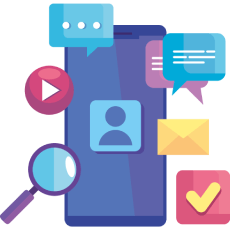The Role of Social Media in Modern Education – Benefits, Challenges, and Examples
Social media was well on its way to claiming a place in everyday life when it started exerting an influence on schools, colleges, and institutes across the globe. Social media was once perceived merely as a distraction, but today, students, teachers, and educational institutions are actively using it in the learning process. Whether it's a few-minute tutorial on YouTube, a Facebook study group, or some tips from a teacher's TikTok page, social media opens up a new way of learning, sharing knowledge, and staying connected. Informal conversations or entertainment are no longer the sole opportunities social media has to offer to education. It is slowly being molded into a modern way of teaching.
Fast Access to Knowledge and Learning Resources

One of the most visible ways social media supports education is through quick and easy access to information. Students no longer have to rely only on textbooks or lectures. They can now search for ideas, summaries, how-to videos, and group discussions that make learning more flexible and immediate. Platforms like YouTube offer free lessons on everything from science experiments to essay writing. Instagram and TikTok are filled with teachers and experts who explain things in short videos that are easy to understand. This has helped students who struggle with traditional classroom settings or prefer learning through visuals and real examples.
A Helpful Tool for Teachers
Teachers also benefit from social media. Many of them use it to share educational content, post updates, and encourage students to ask questions outside of school hours. It opens up better communication and helps teachers build stronger relationships with their students. It's also easier for educators to discover new teaching methods by following others in their field and joining online communities for advice and inspiration. This kind of sharing creates a more supportive environment and encourages professional growth among educators.
Making Learning More Collaborative

Another big benefit is collaboration. Social media allows students to work together no matter where they are. They can share files, discuss homework, and help each other understand lessons using apps like WhatsApp, Discord, and even Instagram messages. Study groups are no longer limited to those who live nearby or attend the same school. With the right tools, students can take part in global learning, connect with others who share similar interests, and even learn about different cultures or opinions. This makes learning more active and engaging, and it also builds important life skills like communication, teamwork, and digital literacy.
Distractions and Misinformation Are Ongoing Concerns
Yet, with opportunities come problems for educators with social media. Among the chief problems is distraction. Most apps encourage educative value, but on the other hand, content is available with no intention of nurturing learning. Students lose concentration or focus as they scroll through posts with no bearing kinds of distractions. An adulteration of false information is another problem. Merely, online popularity does not equate to correctness. Without proper guidance, students may absorb some false facts or hold wrong views on some important subject matters. Teachers/schools must help the students learn to check their sources, develop critical thinking, and use social media responsibly.
Online Safety and Responsible Use Matter
Online safety and privacy are yet other concerns. Not all students know how to protect themselves or inform themselves about negative comments. Through policies, schools must operate workshops that instruct students on proper online behavior, appropriate disclosures, and ways to respond to harmful content. Equally important, parents should be encouraged to discuss internet use with their children and engage in the use of social media. Teaching digital citizenship, or respectful and responsible conduct online, thus has now become an essential component of education.
A Useful Tool When Used the Right Way
To summarize, social media seems to be one of the biggest and growing chains in education nowadays. When used correctly, social networking helps students get instant access to information, collaborate with each other while getting in touch with their teachers, and also provides instructors with newer ways for teaching and knowledge-sharing. But, really, whatever the tool, one makes it work or against him. When properly balanced, social media will complement learning so that it does not interfere with or distract from the actual learning objectives.
Related Articles:
Schools around the world are experimenting with AI tutors, adaptive learning modules, and automated grading systems.
— Artificial Superintelligence Alliance (@ASI_Alliance) February 11, 2025
Is this the dawn of personalized education or a step toward isolating students behind screens? 1/5 pic.twitter.com/YF4PubHjxy
